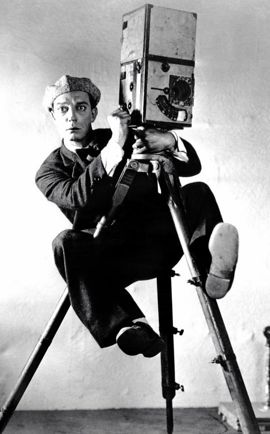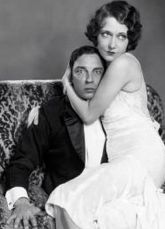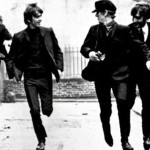 Comedy and tragedy get equal billing in the “Buster Keaton Collection,” an unspooling of three films the silent-era comic made under the thumb of MGM at the dawn of the sound age.
Comedy and tragedy get equal billing in the “Buster Keaton Collection,” an unspooling of three films the silent-era comic made under the thumb of MGM at the dawn of the sound age.
The two-disc Warner/TCM Archives set (retail $39.92) is billed as “a celebration of Keaton’s art,” but the party is best saved for his earlier works as an independent filmmaker — classics such as “The General” and “Steamboat Bill, Jr.”
Of the films here, only the silent “The Cameraman” (1928) comes guaranteed to charm contemporary audiences. The other two — “Spite Marriage” (1929) and the talkie musical “Free and Easy” (1930) — have their moments but play today more as Keaton curiosities.
This set succeeds because its compilers and commentators never flinch in placing the films in their historical context. The later films are in part evidence of an artist’s destruction via corporate abuse and career vandalism.
And so viewers are encouraged to hiss as the studio makes its villainous entrance in “So Funny It Hurt: Buster Keaton at MGM,” a new 40-minute documentary that should be viewed as the gateway to the set.
The actor-director hooked up with the studio in 1928, just four years after it was formed via merger. He later called the move the worst mistake of his career.
Keaton came in as a great comic, the docu says, and went out unemployable five years later. He had descended from auteur to a salaried performer of “childlike idiot parts.” Alcoholism, the loss of his children via divorce and a trip to a sanitarium filled out the nightmare scenario.
The wildly successful “The Cameraman” gives few hints of what was to come. TCM host Robert Osborne calls the film “one of the true Keaton classics,” and it appears here nearly intact, in reasonably good shape. The film’s original negative was lost in a 1960s vault fire, but restorers later located a master positive that had been set aside as source material for an MGM highlights film. The positive was incomplete, however, so video quality on the DVD lurches about a bit.
The film — about a street photographer (Keaton) who heroically stumbles into love and a career at MGM’s newsreel unit — became the studio’s “template for all future comedy films,” commentator Glenn Mitchell notes. For years, all wannabe MGM comics were required to watch, laugh and learn. The documentary uses a split screen to show how MGM recycled Keaton gags with other comedians, notably Red Skelton.
The DVD version of “The Cameraman” comes alive with a new score from Arthur Barrow, an alumnus of Frank Zappa’s later bands. The score respects the silent traditions but doesn’t hesitate to innovate, as in the psychedelic wisps in the opium den scene.
Commentator Mitchell (the book “A-Z of Silent Film Comedy”) provides a good excuse to run the film twice — the British academic has a good story to go with nearly every scene. (He appears to be reading, though, and through some editing error tells the history of the print twice, moments apart.)
Mitchell calls Keaton’s nickname of the Great Stone Face “nonsense,” pointing to an early scene in which the actor adores the heroine from over her shoulder. He had “the most expressive eyes in the business.”
The film is best known for Keaton’s improvised bit on the empty field at Yankee Stadium and its remarkable shootout in which Chinatown gangs attack each other as the brave cameraman cranks away. A tiny monkey steals hearts and the show.
Keaton’s improvisational skills had propelled his silent comedies and made him a star. “Material was the last thing in the world I thought about,” the comic says in a 1960s interview that’s excerpted in the docu. “They only had to turn me loose on the set.” MGM had no such intention, clamping down on Keaton’s improv and his freedom to do the stunts he loved.
 “Spite Marriage” was Keaton’s last silent, famous for its scene in which the comic tries to get his drunken bride onto the bed.
“Spite Marriage” was Keaton’s last silent, famous for its scene in which the comic tries to get his drunken bride onto the bed.
The DVD’s video looks good and is complete. The film has some great gags, with co-star Dorothy Sebastian (left, with Keaton) tough enough to stay right in step with his physical comedy. (The closeness led to an affair.) But while “The Cameraman” still seems fresh, “Spite Marriage” feels like an old movie.
“One must remember that silent comedies need an audience,” says Jeffrey Vance, who shares the commentary with fellow silents historian John Bengtson. “With a crowd, they come to life.”
The audio comes from the original discs played in theaters, synched to supply sound effects. With “The Jazz Singer” debut 18 months earlier, Keaton pushed to use sound, but MGM refused.
The comic got his audio on “Free and Easy,” a Keaton starrer that devolves into an awkward MGM backstage musical. Keaton not only talked, but he also sang and danced on the title number. His loping voice seemed just fine for the talkies, but the jokes are in short supply here. The “Free and Easy” print suffers from plenty of scratches and splotches; there is no commentary to prolong the experience.
Related home video reviews:
- Chaplin’s “Gold Rush” hits motherlode on Blu-ray
- “The Little Rascals”: The kids are all right, still
- Sherlock Holmes on Blu-ray
Glenn Abel on Google+



Leave a Reply